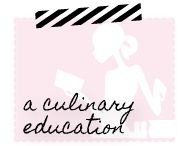This was the first 'specialized' culinary class with George Brown College which I enrolled in after taking the Culinary Arts I & II. I love Italian food....but I do have to confess that I didn't know much about Northern Italian Cuisine prior to taking this course. I thought all Italian food came from the same place...Italy!
(I now understand just how misinformed I was...)
This course is 6 weeks. You'll need a pasta maker, or at least access to a pasta maker. But don't fret too much about this. There are usually enough people in class who bring pasta makers that getting access to one on the day you make pasta is easy enough. You'll also need a Agnolitti stamp (I couldn't find one, so I used a regular round cookie cutter which worked just fine).
The instructor that who taught this class had spent time working as a Chef in different parts of Italy, so he had a lot of good authentic useful tips and stories to make the class interesting.
 |
| Agnolitti Stamp |
Week One: Heavenly potato dumplings in tomato sauce....
As with other Continuing Education Culinary Arts classes, the first thing that was discussed was expectations for the class and any new tool requirements.
This week was a demo only class. Demonstrated was Gnocchi di Patate (Potato Dumplings), Sugo di Pomodoro (a Basic Tomato Sauce), Finissima di Branzino marinata all 'extra virgine' ed insalata Italiana (Marinated Sea Bass with Italian Sauce) and Panna Cotta (Cooked Cream).
So one of my friends is Italian. His parents are super Italian when it comes to the food(I mean that in the best way possible). They even have a pizza oven in their backyard.
 |
| This is the Pizza Oven..... |
The tomato sauce was basic, but the instructor described how it could be built upon to make different variations. In class, the Gnocchi was tossed in the tomato sauce.
The Sea Bass was not cooked, but cured in the fridge with lemon and lime juice. It was then served over a bed of fennel, cucumber, tomato and basil. It was simple and pleasant. This would be a great summer dinner recipe.
The Panna Cotta was rich....(which is not surprising considering it was made with 35% cream)...it was a useful introduction on how to use gelatin.
Week Two: So this is Polenta....hm.
This was the first demo and lab class of the course. Demonstrated in this class was Agnello All Modenese (Lamb 'Modena' Style), Polenta con Gorgonzola, Salsa Funghi (Polenta with Gorgonzola in a Mushroom Sauce) and Pasta e Fagioli alla Veneta (Pasta and Bean Soup Venetian Style). The Lamb and Polenta recipes were part of the lab.
We were shown how to butcher a lamb rack to make little lamb chops (just like the ones that are served in martini glasses with mashed potatoes at cocktail parties).... Once the lamb chops were cleaned off, they were breaded, roasted and then drizzled with balsamic and olive oil. All in all I was happy with the balsamic and herb breaded/roasted flavour of the lamb (even though I am not a huge fan of lamb)....it wasn't too lamb-y (for those of you who don't really like lamb, you'll understand what I mean). And true to the name of the course, Modena is in Northern Italy.
This was my very first introduction to Polenta. And (like the time I ate American southern grits with no cheese or butter or hot sauce) what I discovered is that Polenta with nothing in it doesn't taste like much (it had the same texture as the grits, but it was more solid). It's pretty easy to work with (if you follow the instructions on the polenta flour box) and it will take on the flavour of whatever you cook or bake it with. In this case it was heavily flavoured with giant chunks of Gorgonzola and topped with a mushroom sauce. (there was extra Gorgonzola left over so I went a little crazy with this greenish/bluish cheese...ooops). Turns out Gorgonzola's origins are traced back to a city of the same name in Northern Italy....Boom!
The pasta and bean soup was nice. I can see this being a good 'fall-soup' recipe. The instructor advised us on variations of how to make the soup more flavourful (by adding bacon...YES!).
Week Three: PASTA.
SO this is the week I learned about the magical wonders of homemade pasta. Once you have fresh pasta, there is no comparing it to the dried stuff in the package (don't get me wrong, I still rely on the dried stuff in the packing because, let’s face it, it’s more convenient) but now I know - given the option - I would take fresh pasta any day.
There is an art to making pasta. Thankfully, the instructor was very detailed in the methods and provided many many tips to make the whole thing easier.
Once the pasta was made and put through our pasta machines, we took that same pasta dough and filled it with a ricotta and spinach mixture. We then used the Agnolitti stamps (or in my case, a cookie cutter) to make ravioli.
This entire course was worth it just to learn how to make pasta.
Calamari e Gamberetti Fritti was also demonstrated in this class. This is a basic fried calamari and prawn dish.
Week 4: Parchment Paper
I knew that cooking 'en papillote' was a very delicious French way to have fish....(the first time I had something 'en papillote' I was in Las Vegas in the restaurant up the Eiffel Tower at the Paris Hotel) .
 |
| Black Cod, Fingerling Potatoes, Brown Beech Mushrooms, Lemon "en Papillotte" @Eiffel Tower Restaurant, Las Vegas |
Fagiolli all'uccelletto (Beans Tuscan style) and Fegato di Vitello all Veneziana con crostini di polenta bianca (Calves Liver Venetian Style with Crostini of White polenta) was also demonstrated in this class. This Tuscan (also in Northern Italy) bean recipe is more of a side dish. The beans were flavoured with sage, rosemary, garlic, tomatoes and chili flakes.
The calves liver on white polenta crostini was interesting. I can't say that I would make it again (as I discovered in week 2, I am not a huge fan of polenta)....it didn't occur to me before this class to make crostini out of polenta, so there's that....
Week 5: Bone with a Hole...
Ossobuco translated to english means 'Bone with a Hole'. Sure, okay.
It's a Milanese speciality. Milan is in Northern Italy, so it makes sense that this would be included in this course.
This week Ossi Buchi alla Milanese (Ossobuco), Risotto alla Milanese (Saffron Risotto) and Crostini ai fegati alla Toscana (Liver Crostini Tuscan Style) were demonstrated. The first two recipes (Ossobuco and Risotto) were included in the lab portion of this class. The Ossobuco was pretty labour intensive (I do have an appreciation labour intensive food as I find that the flavours have more depth....however this recipe was a little too labour intensive even for me). Ossobuco is traditionally made with veal, which is what was done in class, but if I ever do this recipe again I will probably use beef instead (I know, this is complete sacrilege to the Ossobuco traditionalists out there, but I am just not a huge fan of veal...).
The Saffron Risotto was fantastic. The saffron added a lovely flavour and colour to the risotto. I have used this recipe with other beef stews in my culinary travels and it's been a perfect match.
The liver crostini was just that. A liver puree with carrots, celery, garlic, capers, anchovy and white wine, spread on crostini.
Week 6: Tiramisu
Having now made Tiramisu (which is included in the lab for this class), I can say that this recipe is not for people who don't like to whisk things. The amount of whisking involved could potentially work up a sweat....(this is most likely because I have no upper body strength, but whatever...). Despite the whisking and mixing, the end product is phenomenal (in my humble opinion). I generally have an aversion to custard/creamy desserts, but this recipe is light and decadent and heavenly. I've made it a couple of times and received many compliments (my adaptation of this recipe will be included in a subsequent post).
Biscotti and Stuffed Olives (Olive Ripiene) are included with the demo.
I love biscotti with a cup of coffee. So I was thrilled to learn some tips and techniques on how to make this successfully (I'll include my toasted almond and chocolate chip biscotti recipe in a subsequent post).
The stuffed olives were stuffed and breaded and deep fried. These were very good, but I think they were too fiddly for me. I would definitely eat them again, but will probably never make them.
I'd recommend Northern Italian Cuisine for anyone who likes and wants to expand their knowledge of Italian regional food. It definitely expanded my culinary ranges and provided me with the confidence to take on some of the more traditional Italian recipes that I come across...(which I used to just leave up to the Nonna's).
As a side note, I bought my pasta maker from Williams Sonoma (http://www.williams-sonoma.com/products/imperia-pasta-machine/ ). I am very happy with it.
Happy Cooking!
Happy Cooking!





















Hi there! Melissa here from Food Bloggers of Canada. Just popping by to check out your blog and to let you know we've added you to our Membership Directroy. Welcome aboard! This class sounds mouthwateringly good! I might have to go find dinner now :)
ReplyDeleteThanks for the add Melissa!
DeleteFound your blog through food bloggers of Canada. Such a wonderful site. I look forward to getting to know you and learn along the way.
ReplyDeleteThanks for the feedback Kim! Have a great day!
DeleteGreat post, I feel like trying them all!
ReplyDeleteI've been using also www.about-italian-food.com for more great recipes and info!
Happy eating,
Mario
Good food brings people together. Finger food is best suited for all occasions, it is light and people love eating it.Will certainly visit your site more often now.
ReplyDeletezonia
Check out the blog below - he's printing your exact words as his
ReplyDeletehttp://escritoasangue.blogspot.ca/2012/01/northern-italian-cuisine.html